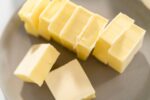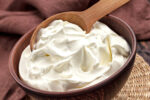
How to Preserve Cheese Without Refrigeration
Electrical refrigeration wasn’t available in homes in the U. S. until around the 1920s. Before then, people had to preserve cheese by other means.
A large round or block of cheese was often purchased to store and use throughout the winter. Cheese was too expensive to allow to mold or dry out.
INFORMATION BELOW FROM 1800s COOKBOOKS
CARE OF CHEESE
The very strong odor and flavor that characterize cheese make it necessary to prevent it from coming in contact with other foods and transmitting its odor and flavor to them.
The best place to keep cheese, particularly the soft varieties, is in the refrigerator,* where it should be placed in a closed receptacle and kept as far as possible from foods that are easily tainted.
It is well to avoid a damp place for the keeping of cheese, as mold frequently develops on the outside when too much moisture is present. But in case mold does appear, it can be removed by cutting a thin slice from the side on which it has grown.
On the other hand, cheese that is kept in a dry place becomes hard and dry unless it is wrapped in oiled paper or a damp cloth wet with vinegar. However, such cheese need not be thrown away, for there are numerous uses, particularly in cooking, to which it can be put.
*refrigerator – wooden boxes lined with tin or zinc, insulated with various materials, and containing a large block of ice were called “refrigerators” until the modern electric refrigerator was developed. Then they were referred to as “iceboxes.”
A WHOLE CHEESE
When a whole cheese is cut, the inside of the larger quantity should be spread with butter or brushed with melted paraffin and the outside wiped, to preserve it.
Or wrap it in paraffin paper, then in a slightly dampened cloth, and then in paper. It should not, however, be kept in the damp cloth too long; as molds will grow upon it.
To keep those in daily use moist, let a clean cloth be wrung out from cold water and wrapt round them when carried from table.
Keep cheese in a cool, dry place, and after it is cut, wrap it in a linen cloth and keep it in a covered tin box.
DRY CHEESE
When partly dry, it should be put through the food chopper using a fine cutter. When very dry, it should be grated and used in sauces, soufflés, soups, and many other dishes.
Old and dry cheese is very good grated and mixed with a little brandy, just enough to wet it up.
If cheese gets hard and loses its flavor, pour some sweet wine over four ounces of pearlash* till the liquor ceases to ferment. Filter the solution, dip into it some clean linen cloths, cover the cheese with them, and put in a cool dry place. Turn the cheese every day, repeat the application for some weeks, and the cheese will recover its former flavor and goodness.
*pearlash – the white powder that remains when potash is baked in a kiln.
MOLD ON CHEESE
Molds grow rapidly upon cheese, especially if it is placed in a warm place and the air is excluded from it. For this reason, cheese should never be placed in a tightly covered dish or jar. Wring a cloth from vinegar and wrap several thicknesses around the cheese to keep it from molding and drying.
The mildew which often forms on cheese can be avoided if a lump of sugar is kept in the cheese dish.
Cheese that is growing moldy can be prevented from becoming any more so by grating it fine, moistening it with wine, and covering it up in a jar.
POTTED CHEESE
Cheese that has begun to mold can be kept from becoming any more so. Cut off the moldy part and pound it fine in a mortar, together with the crust.
To each pound of it, when fine, put a tablespoon of brandy. Mix it in well with the cheese, press it down tight in a clean stone pot, and lay a paper wet in brandy on the top of it. Cover the pot up tight and keep it in a cool, dry place. Potted cheese is best when a year old. It will keep several years, without any danger of its breeding insects.
Potted Cheese No. 2 ~ To a pound of grated Parmesan or Cheshire cheese, add three ounces of cold fresh butter, a little sifted mace, and a teaspoon of mustard. Mix all well in a marble mortar, put it into small pots, cover with clarified butter, and set the pots in a cold dry place.
Potted Cheese No. 3 ~ Cut and pound four ounces of Cheshire cheese, one and a half ounce of fine butter, a teaspoon of white powdered sugar, a little bit of mace, and a glass of white wine. Press it down in a deep pot.
TO PRESERVE CHEESE
Cheeses may be preserved in a perfect state for years by covering them with parchment made pliable by soaking in water, or by rubbing them over with a coating of melted fat. The cheeses selected should be free from cracks or bruises of any kind.
Or cover them carefully with paper or cloth, fastened on with a paste made of wheat flour, so as to exclude the air. In this way, they may be kept free from insects.
TO KEEP CHEESE IN THE WINTER
Take a clean dry barrel, put a little hay at the bottom, and then a cheese. Put hay between each cheese and around it. Keep it covered tight and in the driest part of the cellar, or in an upper room not subject to frost.
Image from Deposit Photos
=================================================
How Do You Prevent Dried or Moldy Cheese? Please Leave a Comment Below.
=================================================



